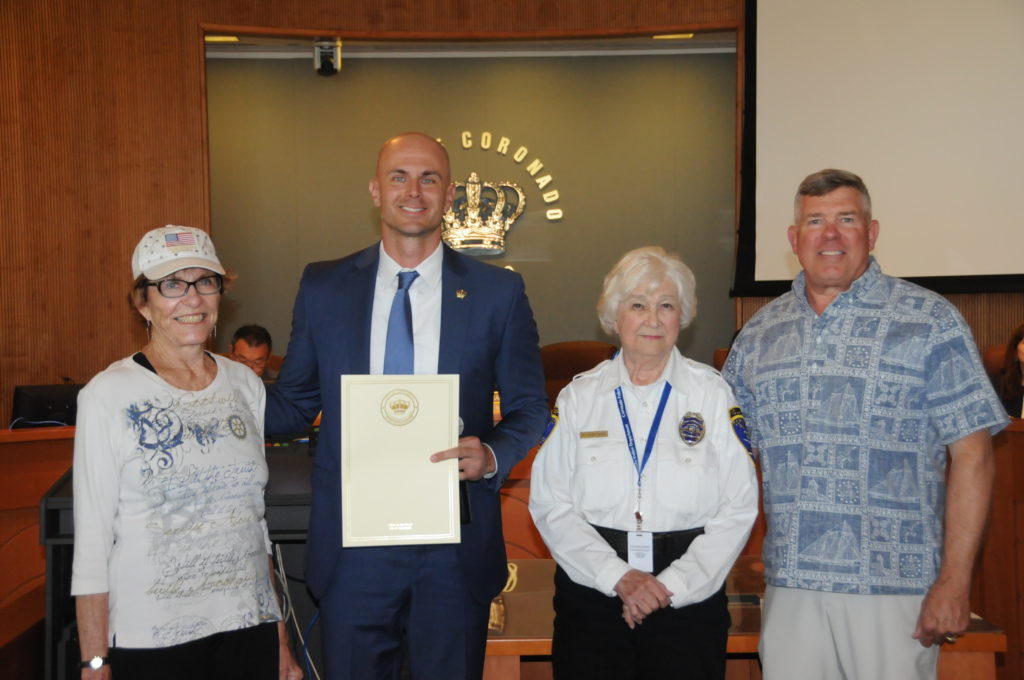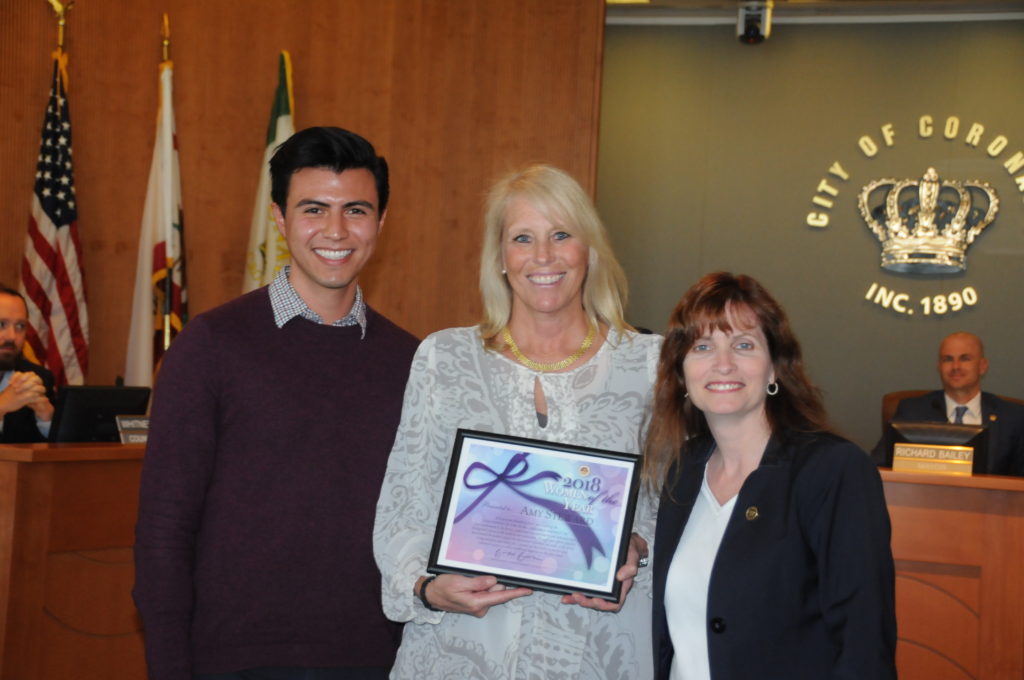 Mayer Richard Bailey presented a ceremonial Proclamation for National Volunteer Week to Wanda Zimmerman, Jim Jamison, and Marilyn Rees. He recognized the reserve police officers, senior volunteers, and police explorers who all support first responders and gave 8738 hours of service within the police department and community in 2017. He also cited middle school and high school students and local service clubs and dedicated community volunteers who support the recreation department, community events and coach youth basketball teams. He mentioned the 29 adult volunteers who gave 2523 hours and 35 junior volunteers who contributed 1125 hours at the Coronado Public Library. He and the City Council proclaimed April 23 – 29, 2018, National Volunteer Week.
Mayer Richard Bailey presented a ceremonial Proclamation for National Volunteer Week to Wanda Zimmerman, Jim Jamison, and Marilyn Rees. He recognized the reserve police officers, senior volunteers, and police explorers who all support first responders and gave 8738 hours of service within the police department and community in 2017. He also cited middle school and high school students and local service clubs and dedicated community volunteers who support the recreation department, community events and coach youth basketball teams. He mentioned the 29 adult volunteers who gave 2523 hours and 35 junior volunteers who contributed 1125 hours at the Coronado Public Library. He and the City Council proclaimed April 23 – 29, 2018, National Volunteer Week.
 Amy Steward was recognized by Councilmember Downey and Javier Gomez from Assemblymember Todd Gloria’s office as “Woman of the Year” for the 78th Assembly District. Some of her impressive accomplishments include founding and running the “Take a Veteran to School Day” for nine years. She also organized and co-chaired an endowment for the school pool and she helps with the Coronado Schools Foundation telethon. She founded and coached San Diego’s first competitive jump rope team called “The Speed Spinners,” who were nationally ranked. She founded “Adopt an Area” which involves students helping with community beautification projects. She was teacher of the year for Coronado Middle School and has served as summer school principal. She also founded KCMS, the student run television station. She introduced bringing education to life programs like the Mission Days celebration for California history, reading programs, Night at the Oscars and dozens of musicals. She has also been recognized by Coronado service clubs, government and military organizations for her numerous contributions. Councilmember Downey thanked her for her amazing service to the community. Councilmember Benzien fondly pointed out that Steward was his 7th grade Home Ec. teacher and he was a Coronado jumper.
Amy Steward was recognized by Councilmember Downey and Javier Gomez from Assemblymember Todd Gloria’s office as “Woman of the Year” for the 78th Assembly District. Some of her impressive accomplishments include founding and running the “Take a Veteran to School Day” for nine years. She also organized and co-chaired an endowment for the school pool and she helps with the Coronado Schools Foundation telethon. She founded and coached San Diego’s first competitive jump rope team called “The Speed Spinners,” who were nationally ranked. She founded “Adopt an Area” which involves students helping with community beautification projects. She was teacher of the year for Coronado Middle School and has served as summer school principal. She also founded KCMS, the student run television station. She introduced bringing education to life programs like the Mission Days celebration for California history, reading programs, Night at the Oscars and dozens of musicals. She has also been recognized by Coronado service clubs, government and military organizations for her numerous contributions. Councilmember Downey thanked her for her amazing service to the community. Councilmember Benzien fondly pointed out that Steward was his 7th grade Home Ec. teacher and he was a Coronado jumper.
Gomez also talked about two bills Gloria’s office is working on. AB 2372, an opt in program which helps low and middle housing production near public transit areas, passed the Housing and Community Development Committee with bi-partisan support and now moves on to our local government committee. AB 2843 gives eligible cities, schools and other districts unused funds from the county that go towards mental health. After three years, unspent dollars would revert back to the state and be redistributed to other public entities to provide mental health services under the scope of the Mental Health Services Act (MHSA).
The hot button topic of the meeting was the historic designation of the house at 1405 10th Street. Councilmember Donovan recused himself because he lives within 500 feet of the property. Tricia Olsen, associate planner for the Historic Resource Commission (HRC) talked about the HRC’s process for historic designation. The commission believes that the house meets both Criterion B for Grace Healy’s prominence as an artist and Franklin Club affiliation and Criterion C as an example of craftsman architectural style, having been built in 1909.
The property owner’s appellate argued that Grace Healy’s contribution as an artist and the Franklin Club did not occur while she occupied the property. He does agree that the house meets Criterion C.
In 1926, Grace Healy and husband Albert, who was in the Canadian Parliament, moved to another home she designed at 940 Glorietta Blvd. now named the AF Healy house, which was designated historic in 2006.
This was a De Novo hearing which means that the council could entertain new information, not limited to HRC information. Olsen suggested the Council consider the HRC hearings, appellate findings, staff report and testimony from today’s hearing to make their decision. Ten community members all spoke in favor of preserving this historic home.
Councilmember Downey expressed that in her research she felt that Criterion A had been met because the house had been turned over from one military family to another and had actually had someone serving on active duty during all of the wars. Also, Commander Greer, who was the commanding officer of the USS California on December 7, 1941, when it was bombed in Pearl Harbor, lived there with his family.
After much discussion, when the Council voted to declare the house historic under Criterions A and C, there was cheering from the audience.
Councilmember Donovan gave an update on the subcommittee to look at the Historic Preservation Program. He and Councilmember Downey will identify potential improvements in next four to six weeks and plan to hold two public forums in late May to finalize input. Their report should be ready to present at the August 21 council meeting with updates planned for June and July.
 Rita Sarich, director, Coronado MainStreet, presented that the upcoming Motorcars on Main Street event will be held on Sunday, April 29 from 10 a.m. to 3 p.m. There are already more than 300 pre-1973 cars registered. She encouraged everyone to come for the music, raffle, car viewing and to see Mayor Bailey select his favorite Coronado car. She said the event draws thousands of spectators and local businesses thrive. She also thanked the residents on Isabella Avenue, Park Place and Star Park Circle.
Rita Sarich, director, Coronado MainStreet, presented that the upcoming Motorcars on Main Street event will be held on Sunday, April 29 from 10 a.m. to 3 p.m. There are already more than 300 pre-1973 cars registered. She encouraged everyone to come for the music, raffle, car viewing and to see Mayor Bailey select his favorite Coronado car. She said the event draws thousands of spectators and local businesses thrive. She also thanked the residents on Isabella Avenue, Park Place and Star Park Circle.
Veleria Fabiszak, a Navy mom with five kids, made another impassioned plea to build a universally accessible playground at Spreckels Park, in conjunction with Shane’s Inspiration, a non-profit organization based in Los Angeles that has built 60 of these specially designed parks across the U.S. She knows first-hand the need to provide true play value for persons with all abilities such as those who are nonverbal, blind, deaf, autistic, and for wounded warriors with young children and grandparents with limited mobility. She is grateful for the upgrades at Tidelands Park, but is advocating for a more comprehensive, centrally located option for the community. Several other community members echoed her sentiments.
Thomas Ritter, assistant city manager, asked for approval of the Annual Report/Management Plan from the Coronado Tourism Improvement District (CTID) Advisory Board and to continue to levy two one half percent assessments within CTID 1 and 2. He introduced Todd Little, executive director, Discover Coronado, to give the presentation. He noted that the “Destination California” event is currently being held at Loews Coronado Bay Resort. Their new “Explorer Campaign – You are not a real explorer until you’ve discovered an island” is targeted to today’s event planners. They look for ways to fill the winter gap between January and April with groups.
In 2017, hotel room revenue was up 44 percent from 2011, partly due to the economy and also due to their marketing efforts. The four resort hotels generated $14.5 million in TOT with an average occupancy rate of 73.2 percent in 2017. The economic impact of conventioneers in 2017 was 84,494 attendees with 188,868 room nights generating a $98.2 million return on group meetings to the Coronado community.
New ideas for 2019 are hiring a Director of Destination Sales and Marketing, and launching a free “Shop Local Shuttle” on November 23 to encourage holiday shoppers. They have been successful with their outreach to attracting swim teams and now want to replicate that to secure Midwest golf teams to come to Coronado during the winter months. For more information, check out their website: https://discovercoronado.com/
City Manager King presented the design of the Second and Orange Parklets Project from Schmidt Design Group. This idea came about after brushed concrete bulbouts were created in these areas to help calm traffic and the public complained of the aesthetics, so it was decided that small parks might be a solution to take away the hard urban edge, which could include tables and chairs, raised planters, concrete medallions with unique designs, and landscaping. Each of the corners would be customized to the needs of the area.
Mayor and Councilmember Donovan had concerns about the $240,000 price tag for mostly cosmetic changes. King shared that the highest ticket item is the decorative concrete flatwork and the medallions. Councilmember Donovan expressed that he would like to see some lower cost options. Councilmember Benzian asked if Coronado history could be incorporated into the medallions. Councilmember Downey recognized that staff did the estimate based on knowing what takes to meet government building codes. The Mayor shared his frustration that 3rd and 4th Streets have been shortchanged, partly due to Caltrans approval. He would like that corridor to become a priority. A community meeting for a demonstration project, which is evolving, is scheduled for next week. This agreement was approved with the dissention of Mayor Bailey.
Mark West, South County representative for the San Diego County Regional Airport Authority and Councilmember from Imperial Beach, gave an update on the San Diego Airport, which is the busiest single run airport in the U.S. two to one.
Traffic at the San Diego Airport is at an all-time high with 22.1 million passengers in 2017 with takeoff and landings growing by 6.2 percent. The first major project to be completed is the new $127 million green build parking plaza located in front of Terminal 2. This 29,001 space parking structure will open in May and will feature three open walkways, local artist designed panels and panoramic glass elevators. This project was completed ahead of schedule and under budget and will positively impact travelers.
The next major project to open will be the $229 million Federal Inspection Service (FIS) Facility. Recent growth in international travel made this an important necessity to accommodate the airport’s growth. Doubling the number of booths will allow 1000 passengers to be processed versus the previous 350 per hour. West cited that domestic passengers account for $30 million per year and international travelers injected $90 million into our region last year. They are working to attract more international non-stop flights.
The next project is the Terminal 1 replacement project. The negotiation process is underway and construction should begin by the end of 2019. Currently half of the passengers use Terminal 1 and this project will be a three phase process to not interrupt flight schedules.
Juan Hernandez, from Congressman Scott Peter’s office, provided an update on the Tijuana sewage spills. They continue to stay engaged with the EPA who is currently funding a diagnostic study through the North American Development Bank (NADB) to examine operations and maintenance procedures in Mexico and alternatives for new and improved infrastructure on both sides of the border to reduce the amount of transboundary sewage flows in the Tijuana River. The EPA expects the study to be completed by the end of the year.
City Manager King, Mayor Bailey and Councilmember Benzian visited Washington, DC to investigate and advocate for transborder sewage issues and cultivated a productive relationship with EPA Special Advisor Ken Wagner. They felt this administration values this issue as a priority. They will continue to work on this important issue.
Councilmember Bill Sandke was absent from this week’s City Council meeting.




